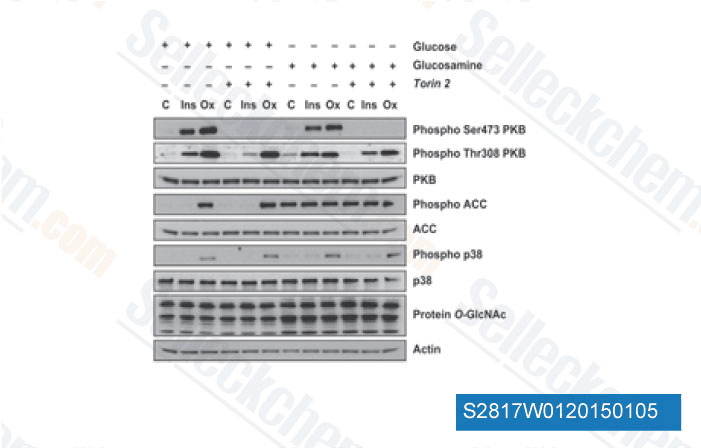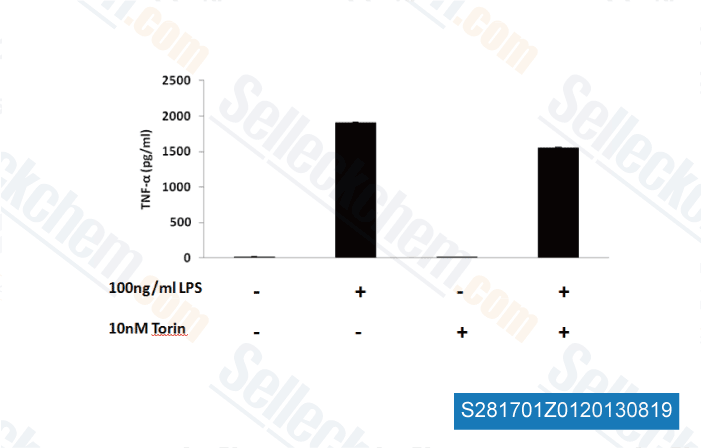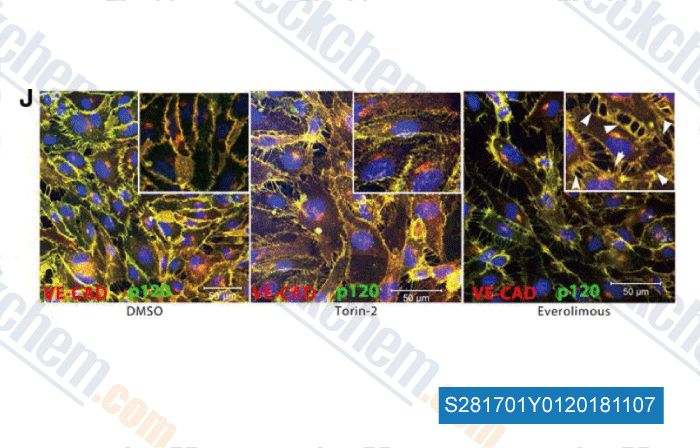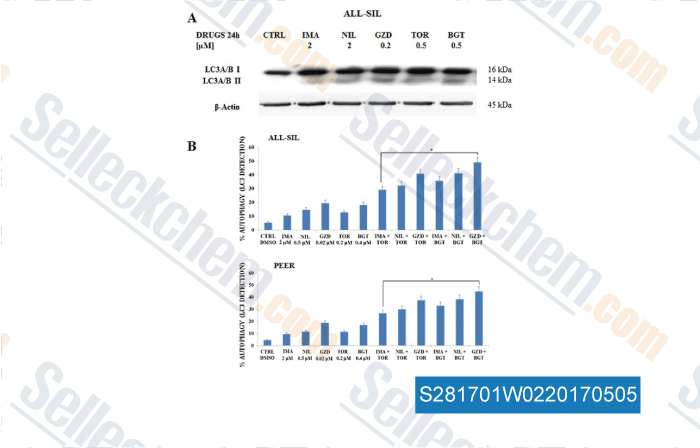|
Toll Free: (877) 796-6397 -- USA and Canada only -- |
Fax: +1-832-582-8590 Orders: +1-832-582-8158 |
Tech Support: +1-832-582-8158 Ext:3 Please provide your Order Number in the email. |
Technical Data
| Formula | C24H15F3N4O |
|||
| Molecular Weight | 432.4 | CAS No. | 1223001-51-1 | |
| Solubility (25°C)* | In vitro | DMSO | 41 mg/mL (94.81 mM) | |
| Water | Insoluble | |||
| Ethanol | Insoluble | |||
|
* <1 mg/ml means slightly soluble or insoluble. * Please note that Selleck tests the solubility of all compounds in-house, and the actual solubility may differ slightly from published values. This is normal and is due to slight batch-to-batch variations. * Room temperature shipping (Stability testing shows this product can be shipped without any cooling measures.) |
||||
Preparing Stock Solutions
Biological Activity
| Description | Torin 2 is a potent and selective mTOR inhibitor with IC50 of 0.25 nM in p53−/− MEFs cell line; 800-fold greater selectivity for mTOR than PI3K and improved pharmacokinetic properties. Inhibition of ATM/ATR/DNA-PK with EC50 of 28 nM/35 nM/118 nM,in PC3 cell lines respectively. Torin 2 decreases cell viability and induces autophagy and apoptosis. | ||||||||
|---|---|---|---|---|---|---|---|---|---|
| Targets |
|
||||||||
| In vitro | Torin 2 has the same binding mode as PI3Kγ, V882 serves as a hinge binding point and in the inner hydrophobic pocket Y867, D841 and D964 provide three more hydrogen bonds with aminopyridine side chain analogous to Y2225, D2195 and D2357 of mTOR. [1] Torin 2 inhibits mTORC1, thus activates TFEB by promoting its nuclear translocation with EC50 of 1.666 mM. [2] Torin 2(< 50 nM) causes a significant reduction in viability of both MZ-CRC-1 and TT cells. Torin 2 (100 nM) exerts a significant reduction of migration of both MZ-CRC-1 and TT cells. [3] |
||||||||
| In vivo | Torin 2 exhibits >95% pharmacodynamic response and half-time of 11.7 min in the mouse liver microsome stability study. Torin 2 exhibits the best bioavailability (51%), short half-life (0.72 hours) and low clearance(19.6 mL/min/kg) in male Swiss albino mice following intravenous and oral administration. [1] Torin 2(20mg/kg) ablates MYCN tumors with reduction in MYCN protein levels and induction of apoptosis in Th-MYCN mice. [4] |
Protocol (from reference)
| Kinase Assay: |
|
|---|---|
| Cell Assay: |
|
| Animal Study: |
|
References
Customer Product Validation

-
Data from [Data independently produced by FEBS J, 2014, 281(16), 3591-608]

-
,

-
Data from [Data independently produced by , , Arterioscler Thromb Vasc Biol, 2018, doi:10.1161/ATVBAHA.118.311321]

-
Data from [Data independently produced by , , Oncotarget, 2016, 7(48):79842-79853]
Selleck's Torin 2 has been cited by 70 publications
| Dynamic regulation of autophagy during Semliki Forest virus infection of neuroblastoma cells [ J Gen Virol, 2025, 106(3)002086] | PubMed: 40042894 |
| Androgen receptor monomers and dimers regulate opposing biological processes in prostate cancer cells [ Nat Commun, 2024, 15(1):7675] | PubMed: 39227594 |
| Endothelial Mechanistic Target of Rapamycin Activation with Different Strains of R. rickettsii: Possible Role in Rickettsial Pathogenesis [ Microorganisms, 2024, 12(2)296] | PubMed: 38399700 |
| Analysis of ATG4C function in vivo [ Autophagy, 2023, 19(11):2912-2933] | PubMed: 37459465 |
| Analysis of ATG4C function in vivo [ Autophagy, 2023, 19(11):2912-2933] | PubMed: 37459465 |
| Continuous sensing of nutrients and growth factors by the mTORC1-TFEB axis [ Elife, 2023, 12e74903] | PubMed: 37698461 |
| Sequential Treatment with Temozolomide Plus Naturally Derived AT101 as an Alternative Therapeutic Strategy: Insights into Chemoresistance Mechanisms of Surviving Glioblastoma Cells [ Int J Mol Sci, 2023, 24(10)9075] | PubMed: 37240419 |
| Myc controls NK cell development, IL-15-driven expansion, and translational machinery [ Life Sci Alliance, 2023, 6(7)e202302069] | PubMed: 37105715 |
| Dephosphorylation of 4EBP1/2 Induces Prenatal Neural Stem Cell Quiescence [ bioRxiv, 2023, 2023.02.14.528513] | PubMed: 36824760 |
| Characterization of the autophagy-modulating natural compound prodigiosin for the elimination of therapy-resistant tumor cells [ DNB, 2023, ] | PubMed: none |
RETURN POLICY
Selleck Chemical’s Unconditional Return Policy ensures a smooth online shopping experience for our customers. If you are in any way unsatisfied with your purchase, you may return any item(s) within 7 days of receiving it. In the event of product quality issues, either protocol related or product related problems, you may return any item(s) within 365 days from the original purchase date. Please follow the instructions below when returning products.
SHIPPING AND STORAGE
Selleck products are transported at room temperature. If you receive the product at room temperature, please rest assured, the Selleck Quality Inspection Department has conducted experiments to verify that the normal temperature placement of one month will not affect the biological activity of powder products. After collecting, please store the product according to the requirements described in the datasheet. Most Selleck products are stable under the recommended conditions.
NOT FOR HUMAN, VETERINARY DIAGNOSTIC OR THERAPEUTIC USE.
